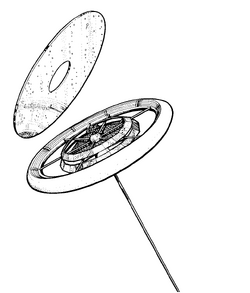
A Stanford Torus
A Stanford Torus is a proposed design for a space habitat that is capable of housing 10,000 permanant residents. This is the principle design considered by NASA during a 10 week study of space colonization.
It consists of a torus, or doughnut-shaped ring, with a central "hub" in the middle. The torus is connected to the hub by six spokes. The colony is one mile (1.8km) and rotates once per minute to provide gravity on the inside of the outer ring. That ring is where people live.
Sunlight is reflected inside the colony by a system of mirrors.
Since the hub is at the rotational axis of the station, it experiences the least artificial gravity and is the easiest location for to dock. Zero-gravity industry is performed in a non-rotating module attached to the hub's axis.
The interior space of the torus itself is used as living space, and is large enough that a "natural" environment can be simulated; the torus appears similar to a long, narrow, straight glacial valley whose ends curve upward and eventually meet overhead to form a complete circle. The population density is similar to a dense suburb, with part of the ring dedicated to agriculture and part to housing.
| This page uses Creative Commons Licensed content from Wikipedia (view authors). | 
|